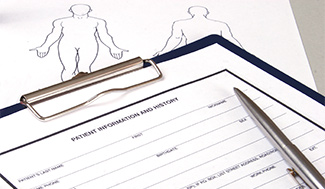Posted by Team KMCU on Oct 24, 2025
Is Your iPad or Sign-In Kiosk HIPAA Compliant?
Here’s What Every Chiropractor Should Know
Hot Topics from the KMC University HelpDesk
More chiropractic offices are moving from paper sign-in sheets to digital kiosks and tablets—but is your setup actually HIPAA compliant? The shift to modern technology improves efficiency, yet it also introduces new compliance risks. Understanding HIPAA compliance for iPad sign-in kiosks is crucial to keeping your patients’ information safe.
Digital Sign-In Sheets: Convenience Meets Compliance

Using an iPad or tablet at the front desk can streamline patient intake, reduce paper clutter, and simplify data entry. However, these devices can also expose sensitive health information if not properly configured. HIPAA compliance is not just about the device—it’s about how you set it up, secure it, and manage it.
To stay compliant, separate personal and business data. That means your iPad should use a business Apple ID, not a personal one. Never sync patient information to iCloud—Apple’s consumer terms of service explicitly prohibit storing or transmitting protected health information (PHI).
Essential iPad Settings for HIPAA Compliance
To secure your digital sign-in kiosk, enable these critical settings:
- Guided Access: Locks the iPad to a single app, preventing users from accessing messages, Safari, or other functions.
- Password Protection: Encrypts the device to protect PHI if it’s lost or stolen.
- Remote Wipe & GPS Tracking: Allows you to locate or erase the device remotely if necessary.
- Business Apple ID: Keeps all patient data separate from personal apps and devices.
These settings form the foundation of HIPAA compliance for iPads used in chiropractic practices.
Understand Vendor Shared Responsibility
Your EHR or check-in vendor also plays a role in compliance—but their Business Associate Agreement (BAA) doesn’t cover everything. Most agreements include shared responsibility, meaning you must configure your systems properly and maintain security standards on your end.
If a breach occurs and your settings weren’t compliant, liability may fall on you—not the vendor. Always review vendor terms carefully and confirm you’re following every required configuration guideline.
Avoid These Common Mistakes
Many well-meaning offices make simple errors that lead to violations:
- Using a personal Apple ID or iCloud for business
- Failing to enable Guided Access or passcodes
- Ignoring shared responsibility clauses in vendor contracts
- Not reviewing HIPAA security updates or performing risk assessments
Each of these oversights can create vulnerabilities that put your practice and patients at risk.
The Bottom Line
Switching to digital sign-in sheets can transform your patient experience—but only if your system is secure. By following HIPAA compliance best practices for iPad sign-in kiosks, you can protect your data, streamline operations, and maintain patient trust.
If you’re unsure about your setup or need help evaluating your HIPAA compliance, Schedule a Solution Consultation with KMC University. Our specialists can review your configuration, identify gaps, and help ensure your digital workflow meets every requirement.







Comments on HIPAA Compliance for Sign-In Kiosks: Don’t Let Your iPad Be the Weak Link